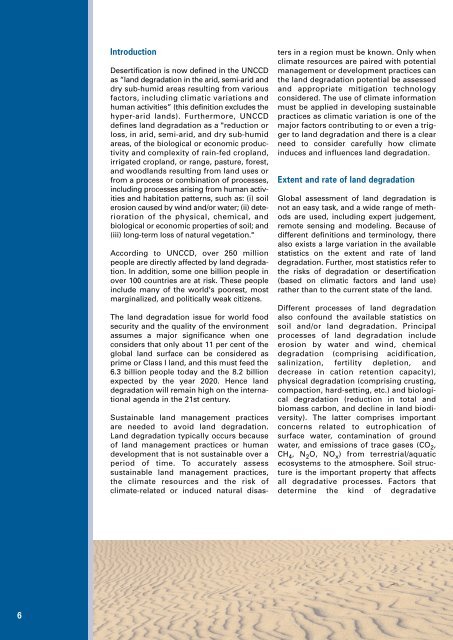Climate and Land Degradation - WMO
Climate and Land Degradation - WMO
Climate and Land Degradation - WMO
You also want an ePaper? Increase the reach of your titles
YUMPU automatically turns print PDFs into web optimized ePapers that Google loves.
Introduction<br />
Desertification is now defined in the UNCCD<br />
as “l<strong>and</strong> degradation in the arid, semi-arid <strong>and</strong><br />
dry sub-humid areas resulting from various<br />
factors, including climatic variations <strong>and</strong><br />
human activities” (this definition excludes the<br />
hyper-arid l<strong>and</strong>s). Furthermore, UNCCD<br />
defines l<strong>and</strong> degradation as a "reduction or<br />
loss, in arid, semi-arid, <strong>and</strong> dry sub-humid<br />
areas, of the biological or economic productivity<br />
<strong>and</strong> complexity of rain-fed cropl<strong>and</strong>,<br />
irrigated cropl<strong>and</strong>, or range, pasture, forest,<br />
<strong>and</strong> woodl<strong>and</strong>s resulting from l<strong>and</strong> uses or<br />
from a process or combination of processes,<br />
including processes arising from human activities<br />
<strong>and</strong> habitation patterns, such as: (i) soil<br />
erosion caused by wind <strong>and</strong>/or water; (ii) deterioration<br />
of the physical, chemical, <strong>and</strong><br />
biological or economic properties of soil; <strong>and</strong><br />
(iii) long-term loss of natural vegetation."<br />
According to UNCCD, over 250 million<br />
people are directly affected by l<strong>and</strong> degradation.<br />
In addition, some one billion people in<br />
over 100 countries are at risk. These people<br />
include many of the world's poorest, most<br />
marginalized, <strong>and</strong> politically weak citizens.<br />
The l<strong>and</strong> degradation issue for world food<br />
security <strong>and</strong> the quality of the environment<br />
assumes a major significance when one<br />
considers that only about 11 per cent of the<br />
global l<strong>and</strong> surface can be considered as<br />
prime or Class I l<strong>and</strong>, <strong>and</strong> this must feed the<br />
6.3 billion people today <strong>and</strong> the 8.2 billion<br />
expected by the year 2020. Hence l<strong>and</strong><br />
degradation will remain high on the international<br />
agenda in the 21st century.<br />
Sustainable l<strong>and</strong> management practices<br />
are needed to avoid l<strong>and</strong> degradation.<br />
L<strong>and</strong> degradation typically occurs because<br />
of l<strong>and</strong> management practices or human<br />
development that is not sustainable over a<br />
period of time. To accurately assess<br />
sustainable l<strong>and</strong> management practices,<br />
the climate resources <strong>and</strong> the risk of<br />
climate-related or induced natural disasters<br />
in a region must be known. Only when<br />
climate resources are paired with potential<br />
management or development practices can<br />
the l<strong>and</strong> degradation potential be assessed<br />
<strong>and</strong> appropriate mitigation technology<br />
considered. The use of climate information<br />
must be applied in developing sustainable<br />
practices as climatic variation is one of the<br />
major factors contributing to or even a trigger<br />
to l<strong>and</strong> degradation <strong>and</strong> there is a clear<br />
need to consider carefully how climate<br />
induces <strong>and</strong> influences l<strong>and</strong> degradation.<br />
Extent <strong>and</strong> rate of l<strong>and</strong> degradation<br />
Global assessment of l<strong>and</strong> degradation is<br />
not an easy task, <strong>and</strong> a wide range of methods<br />
are used, including expert judgement,<br />
remote sensing <strong>and</strong> modeling. Because of<br />
different definitions <strong>and</strong> terminology, there<br />
also exists a large variation in the available<br />
statistics on the extent <strong>and</strong> rate of l<strong>and</strong><br />
degradation. Further, most statistics refer to<br />
the risks of degradation or desertification<br />
(based on climatic factors <strong>and</strong> l<strong>and</strong> use)<br />
rather than to the current state of the l<strong>and</strong>.<br />
Different processes of l<strong>and</strong> degradation<br />
also confound the available statistics on<br />
soil <strong>and</strong>/or l<strong>and</strong> degradation. Principal<br />
processes of l<strong>and</strong> degradation include<br />
erosion by water <strong>and</strong> wind, chemical<br />
degradation (comprising acidification,<br />
salinization, fertility depletion, <strong>and</strong><br />
decrease in cation retention capacity),<br />
physical degradation (comprising crusting,<br />
compaction, hard-setting, etc.) <strong>and</strong> biological<br />
degradation (reduction in total <strong>and</strong><br />
biomass carbon, <strong>and</strong> decline in l<strong>and</strong> biodiversity).<br />
The latter comprises important<br />
concerns related to eutrophication of<br />
surface water, contamination of ground<br />
water, <strong>and</strong> emissions of trace gases (CO 2 ,<br />
CH 4 , N 2 O, NO x ) from terrestrial/aquatic<br />
ecosystems to the atmosphere. Soil structure<br />
is the important property that affects<br />
all degradative processes. Factors that<br />
determine the kind of degradative<br />
6












![View full document [PDF 988.55 KB] - PreventionWeb](https://img.yumpu.com/47733942/1/184x260/view-full-document-pdf-98855-kb-preventionweb.jpg?quality=85)
![View full document (in French) [PDF 4.96 MB] - PreventionWeb](https://img.yumpu.com/47223870/1/184x260/view-full-document-in-french-pdf-496-mb-preventionweb.jpg?quality=85)


![View full document [PDF 25.02 MB] - PreventionWeb](https://img.yumpu.com/44204570/1/190x234/view-full-document-pdf-2502-mb-preventionweb.jpg?quality=85)
